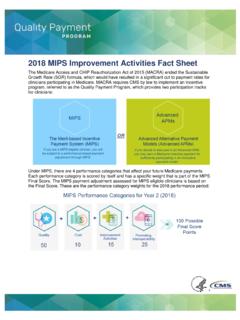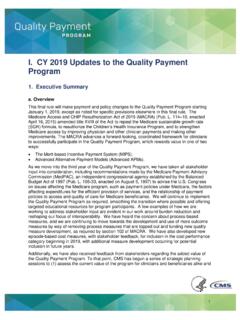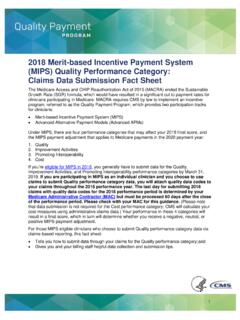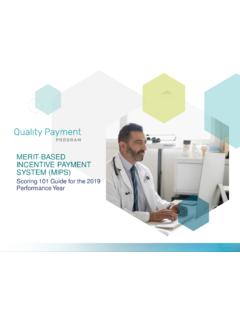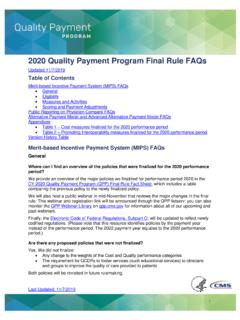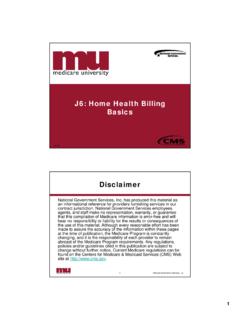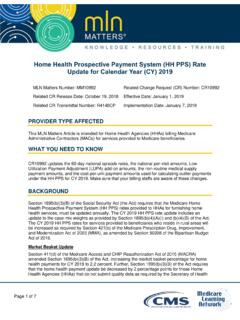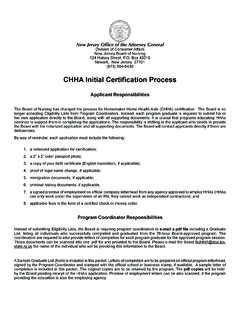Transcription of 2018 Merit-based Incentive Payment System (MIPS ...
1 1 2018 Merit-based Incentive Payment System (MIPS) Participation & Overview The Medicare Access and CHIP Reauthorization Act of 2015 (MACRA) ended the Sustainable Growth Rate (SGR) formula, which would have resulted in a significant cut to Payment rates for clinicians participating in Medicare. MACRA requires CMS by law to implement an Incentive program, referred to as the Quality Payment Program, which provides two participation tracks for clinicians: This fact sheet is divided into three sections: Quality Payment Program Year 2: MIPS participation Quality Payment Program Year 2: MIPS policy highlights Quality Payment Program: Comparing final Year 1 & Year 2 policies Quality Payment Program Year 2: MIPS participation Who can participate in Year 2?
2 For the 2018 MIPS performance year (Year 2), the following clinician types are eligible for MIPS: Physicians, which includes doctors of medicine, doctors of osteopathy (including osteopathic practitioners), doctors of dental surgery, doctors of dental medicine, doctors of podiatric medicine, doctors of optometry, and chiropractors; Physician assistants (PAs); Nurse practitioners (NPs); Clinical nurse specialists; Certified registered nurse anesthetists; and Any clinician group that includes one of the professionals listed above. 2 How Do I Know If I m Eligible?
3 The MIPS Participation Status look-up tool is a resource on allowing clinicians and their support staff to enter a National Provider Identifier (NPI) to determine if a clinician who bills Medicare is eligible and should therefore participate in and submit data to MIPS. The tool reflects MIPS eligibility for clinicians based on clinician type and Medicare enrollment date. It also includes their eligibility for each practice association (as identified by TIN) based on low-volume threshold calculations, as well as information about special status, such as being hospital-based.
4 (More information about the low-volume threshold, special status, and determination periods is provided later in this fact sheet.) Currently, the look-up tool displays from the first determination period (historical data from September 1, 2016 through August 31, 2017.) If the look-up tool indicates a clinician isn t eligible for MIPS at the individual and/or group level, the eligibility status generally won t change at the practices displayed on the tool. Exceptions: o If a MIPS eligible clinician joins a new practice between September 1, 2017 and August 31, 2018, he or she may become individually eligible for MIPS based on the second low-volume threshold analysis of claims submitted under that new TIN/NPI combination.
5 O Eligibility status might change for clinicians participating in an Alternative Payment Model (APM). The tool will be expanded in late Spring 2018 to include both 2018 APM participation and predictive Qualifying APM Participant (QP) status. If the look-up tool indicates a clinician is eligible for ( included in ) MIPS at the individual and/or group level, the eligibility status may change during the 2018 performance period if the clinician or group falls below the low-volume threshold during the second determination period, which will include an assessment of Medicare Part B claims data from September 1, 2017 through August 31, 2018.
6 The MIPS Participation Status look-up tool will be updated to reflect eligibility information from the second determination period (September 1, 2017 August 31, 2018) in late 2018. 3 What Do I Do Now? If the clinician is eligible for MIPS, the clinician: o Will choose whether to participate at the individual or group level. Exception: MIPS eligible clinicians in a MIPS APM will participate at the MIPS APM entity level. o Will start to collect performance data for services furnished January 1 December 31, 2018. o Will determine their submission mechanism(s) for the Quality, Promoting Interoperability (formerly Advancing Care Information), and Improvement Activities performance categories.
7 (Note that advance registration is required for some submission mechanisms. More information is available on the QPP website.) o Will submit MIPS 2018 performance period data to Medicare no later than March 31, 2019. Clinicians who are eligible for MIPS in the 2018 performance period but don t submit data will be subject to the maximum negative Payment adjustment (-5%) in 2020. o Will receive a Payment adjustment (positive, neutral, or negative), based on the data submitted, which will affect his or her 2020 Medicare Part B payments for covered professional services under or based on the Physician Fee Schedule (PFS).
8 If the clinician is not eligible for MIPS, the clinician: o Will not receive a Payment adjustment in 2020 under MIPS. o Is not required to take further action unless his or her TIN decides to participate as a group or Virtual Group, or is identified as a MIPS APM participant, and the group, Virtual Group, or MIPS APM entity is above the low volume threshold. o Can voluntarily participate in the program. Voluntary Participation Clinicians who do not meet the definition of a MIPS eligible clinician in Year 2 may choose to voluntarily submit data individually to Medicare to learn, to obtain feedback on Quality, Promoting Interoperability, and Cost measures, and to prepare in the event MIPS is expanded in the future.
9 Clinicians who submit data voluntarily will not receive a Payment adjustment. 4 Clinicians Practicing in Critical Access Hospitals, Rural Health Clinics, Federally Qualified Health Centers, Ambulatory Surgical Centers, Home Health Agencies, and Hospital Outpatient Departments MIPS Participation for Clinicians Practicing in Critical Access Hospitals (CAHs) Clinicians included in MIPS and practicing in CAHs are required to participate in MIPS unless they are deemed ineligible. For MIPS eligible clinicians practicing in Method I CAHs, the MIPS Payment adjustment would apply to payments made for covered professional services under the Physician Fee Schedule (PFS) that are Medicare Part B allowed charges billed by the MIPS eligible clinicians.
10 The Payment adjustment will not apply to the facility Payment to the CAH itself. For MIPS eligible clinicians practicing in Method II CAHs who have assigned their billing rights to the CAH, CMS would apply the MIPS Payment adjustment to the Method II CAH payments. For MIPS eligible clinicians practicing in Method II CAHs that have not assigned their billing rights to the CAH, the MIPS Payment adjustment would apply in the same way as for MIPS eligible clinicians who bill for covered professional services in Method I CAHs. MIPS Participation for Clinicians Practicing in Rural Health Clinics (RHCs) or Federally Qualified Health Centers (FQHCs) Clinicians practicing in RHCs or FQHCs who provide services that are billed exclusively under the RHC or FQHC Payment methodologies are not required to participate in MIPS (they may voluntarily submit data on measures and activities under MIPS) and are not subject to a Payment adjustment.
